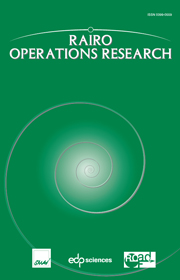Article contents
Dynamic estimation of evidence discounting rates based on information credibility
Published online by Cambridge University Press: 22 December 2010
Abstract
Information quality is crucial to any information fusion system as combining unreliable or partially credible pieces of information may lead to erroneous results. In this paper, Dempster-Shafer theory of evidence is being used as a framework for representing and combining uncertain pieces of information. We propose a method of dynamic estimation of evidence discounting rates based on the credibility of pieces of information. The credibility of a piece of information Cre(I n ) is evaluated through a measure of consensus (corroboration degree) between a set of belief functions, and this measure serves as a basis for quantifying the credibility of the source (sensor or fusion node) itself, Cre(S k ), used then as a discounting factor for all further belief functions provided by S k . The process is dynamic in the sense that the credibility of the source is revisited in the light of new incoming piece of information. The method proposed relies on a hybrid fusion topology in which the sensors are grouped according to the feature they measure (similar and dissimilar sensors), allowing to select different kinds of measure for estimating the corroboration degrees. Through simulations, we compare (a) the hybrid-combination using the source credibility and the robust combination rule (RCR-L) accounting automatically for sensors's credibility; (b) the hybrid-combination, with different membership degrees and corroboration degrees used to estimate the sources credibility. We show that the new hybrid topology together with the credibility-based evidence discounting estimation algorithm provide a faster identification of the observed object.
Information
- Type
- Research Article
- Information
- Copyright
- © EDP Sciences, ROADEF, SMAI, 2010
References
- 5
- Cited by

